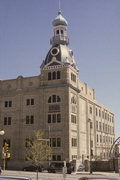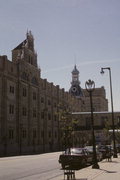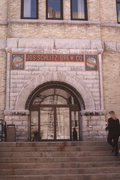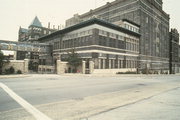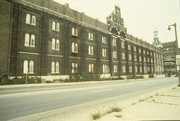Property Record
235 W GALENA ST (AKA 227 W PLEASANT ST)
Architecture and History Inventory
| Historic Name: | Joseph Schlitz Brewing Company Stock and Malt House |
|---|---|
| Other Name: | Schlitz General Office Building |
| Contributing: | Yes |
| Reference Number: | 16349 |
| Location (Address): | 235 W GALENA ST (AKA 227 W PLEASANT ST) |
|---|---|
| County: | Milwaukee |
| City: | Milwaukee |
| Township/Village: | |
| Unincorporated Community: | |
| Town: | |
| Range: | |
| Direction: | |
| Section: | |
| Quarter Section: | |
| Quarter/Quarter Section: |
| Year Built: | 1886 |
|---|---|
| Additions: | 1936 |
| Survey Date: | 1982 |
| Historic Use: | brewery/distillery/winery |
| Architectural Style: | German Renaissance Revival |
| Structural System: | |
| Wall Material: | Cream Brick |
| Architect: | Fred W. Wolf-1886 |
| Other Buildings On Site: | |
| Demolished?: | No |
| Demolished Date: |
| National/State Register Listing Name: | Joseph Schlitz Company Brewery Complex |
|---|---|
| National Register Listing Date: | 12/30/1999 |
| State Register Listing Date: | 7/16/1999 |
| National Register Multiple Property Name: |
| Additional Information: | A 'site file' exists for this property. It contains additional information such as correspondence, newspaper clippings, or historical information. It is a public record and may be viewed in person at the State Historical Society, Division of Historic Preservation. [See Site file is located under title: Joseph Schlitz ...] Milwaukee became “Beertown” because brewers including the now-defunct Schlitz Brewing Company made it famous. Schlitz originated in 1849, when August Krug opened a brewery near the corner of Fourth and Highland-—one of many German-immigrant industrial ventures along the Milwaukee River. Krug died in 1858, and his bookkeeper Joseph Schlitz bought the business. In 1870 Schlitz moved it upriver to create a larger brewery at Third and Walnut. Success largely resulted from opportunistic marketing. After the great Chicago fire of 1871 Schlitz shipped beer there, winning Schlitz many new customers, thereby, legend claims, Schlitz earned its slogan "The Beer that Made Milwaukee Famous." Schlitz died in 1875, but his four nephews named Uihlein, took control and by 1900, Schlitz was America’s third biggest brewery. Schlitz was the nation's largest brewer in the 1940s, and in the 1950s pioneered a trend toward building new breweries and buying regional competitors. But labor troubles, quality-control problems, and marketing woes eroded the company's position throughout the 1960s and 1970s. Though still America’s third-largest brewer in, Schlitz shut its flagship Milwaukee brewery in 1981 and sold out to Detroit's Stroh the next year. But the Schlitz and Uihlein names remain prominent in Milwaukee, and the Schlitz Brewing Company Complex, while partly demolished, still offers a glimpse of the industry. Start your tour at the southeast corner of West Galena Street and King Drive. The two-story cream-brick building here (221-235 West Galena Street) originally served as the brewery office building; part of it now houses Milwaukee County offices. The unimpressive exterior houses a faithfully reproduced German-style rathskeller inside, built by Schlitz as a tourist-hospitality room in the 1930s. Today it is a restaurant. After the rathskeller, trace each brewing process step from building to building, starting in the Romanesque Revival edifice looming over the alleyway, one door east of the rathskeller. This was the brewhouse, dating from 1890, where massive copper kettles heated water and malted barley to produce wort, which was transferred to additional vessels where the wort was boiled with hops. The staircases of the brewhouse's soaring, sky-lit interior are adorned with delightful ironwork, including balustrades adorned with hop-flower motifs and newel caps in the shape of beer barrels. From the brewhouse, the liquid wort was piped into stock houses for fermentation. The largest and only survivor stands at the northeast corner of King Drive and West Galena Street, stretching almost the entire block north to Walnut. Completed in 1900, this massive structure housed rows of refrigerated tanks, where wort fermented with yeast to produce beer. Today it houses a junior high school. This stock house is the most eye-catching building left in the complex, with load-bearing cream-brick walls, trimmed with limestone, sheet metal, and terracotta. German Renaissance Revival features include a stepped and scrolled gable on the King Drive facade, ornamented with a plaque depicting Schlitz's trademark, and a stocky slate-roofed corner tower capped with a bulbous copper dome. Once fermented in the stock house, the finished beer was pumped into the 1902 bottling plant on the eastern edge of the complex at 1560 North Second Street. Here beer was poured into bottles, cans, and kegs. Like the stock house, the bottling plant features Romanesque round-topped windows and brick corbeling. Terracotta details, including foliated plaques and another belted globe, highlight a curiously flattened, stepped gable. After packaging the beer, Schlitz employees had to deliver it. In the days before motorized trucks, Schlitz maintained a huge stable of horses and a fleet of wagons to haul its cases and kegs to every thirsty neighborhood in the city. The old stable, dating from 1896, is at the northwest corner of Second and Walnut. Even this utilitarian building shows some bold sculptural ornament. On the Walnut Street facade are lifelike terracotta horses' heads, wild-eyed and chomping at the bit. While Schlitz's surviving buildings illustrate the brewing process, none survive to document the malting process. Trains would deliver barley to Schlitz's massive grain elevators, the largest located at the northwest corner of Second and Cherry. Grain was transferred to a malthouse, on the east side of Third Street, between Cherry and Court. There, barley was soaked, germinated, then roasted in a kiln, before being funneled back to the brewhouse to begin the brewing process. |
|---|---|
| Bibliographic References: | ZIMMERMAN, 193. BUILT IN MILWAUKEE, LANDSCAPE RESEARCH, P. 148. Sanborn Insurance Maps 1910 Milwaukee Landmarks Application Commercial File- Joseph Schlitz Brewery. Buildings of Wisconsin manuscript. MILWAUKEE ETHNIC COMMERCIAL AND PUBLIC BUILDINGS TOUR, CITY OF MILWAUKEE DEPARTMENT OF CITY DEVELOPMENT, 9/1994. |
| Wisconsin Architecture and History Inventory, State Historic Preservation Office, Wisconsin Historical Society, Madison, Wisconsin |

